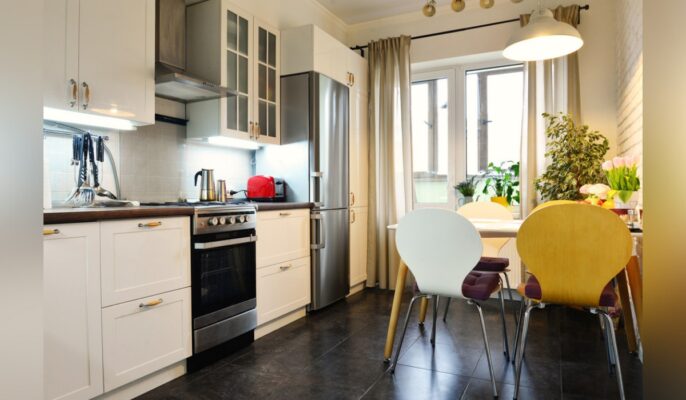In the modern age of compact living, where urban spaces are at a premium, the challenge of designing an efficient and functional kitchen in a limited area has become increasingly prevalent. This predicament has led to a surge in the popularity of modular kitchen designs, particularly those incorporating minimalistic elements. Characterized by their clean lines, uncluttered surfaces, and efficient use of space, these kitchens not only provide the necessary functionality but also exude a sense of sophistication and simplicity. Let’s explore some ingenious and space-saving modular kitchen ideas specifically tailored for small homes, blending efficiency with elegance seamlessly.
1. Open Shelves and Minimalist Storage Units: Embrace the minimalistic approach by opting for open shelves and cabinets with sleek designs. Avoid bulky handles and go for integrated or recessed handles to maintain a seamless and uncluttered appearance. This not only maximizes space but also creates an illusion of a larger kitchen. Choose neutral colors or subtle shades to add an airy and spacious feel to the area.
2. Compact Kitchen Islands and Rolling Carts: Incorporating a compact kitchen island or a rolling cart can offer additional workspace and storage without consuming much floor area. Opt for sleek designs with built-in storage to ensure every inch serves a purpose. These multipurpose units can also act as a breakfast counter or a dining area, eliminating the need for a separate dining space.
3. Foldable and Sliding Components: Integrate foldable or sliding elements such as tables, countertops, or cabinets that can be tucked away when not in use. These innovative components enable you to transform the kitchen into a multifunctional space, providing flexibility and convenience while optimizing the available area efficiently.
4. Strategic Lighting and Reflective Surfaces: Utilize strategic lighting options such as recessed lighting, under-cabinet LED lights, and pendant lights to create an illusion of a larger space. Incorporate reflective surfaces like glossy cabinets or mirrored backsplashes to amplify the natural light and visually expand the kitchen area. Well-placed lighting not only enhances functionality but also contributes to the overall aesthetic appeal.
5. Multi-Functional Appliances: Opt for multi-functional appliances that serve multiple purposes, saving both space and resources. Consider built-in microwave ovens, compact dishwashers, and combination appliances that integrate various functions into a single unit. This approach not only optimizes countertop space but also reduces the need for multiple bulky appliances.
6. Smart Storage Solutions: Integrate smart storage solutions such as pull-out cabinets, corner units, and vertical storage racks to utilize every nook and cranny efficiently. Customize drawers and cabinets to accommodate specific kitchen essentials, ensuring a clutter-free and organized cooking space. Incorporate adjustable shelves and dividers to cater to varying storage needs, thereby maximizing the available space to its fullest potential.
7. Neutral Color Palettes and Streamlined Designs: Opt for a neutral color palette with subtle accents to create an inviting and visually appealing kitchen space. Choose monochromatic tones or complementary hues that promote a sense of tranquility and harmony. Emphasize streamlined designs with minimal ornamentation to maintain the overall simplicity and elegance, enhancing the visual appeal of the kitchen.
8. Integrated Appliances and Hidden Hardware: Consider integrating appliances seamlessly into the kitchen cabinetry to maintain a uniform and unobtrusive appearance. Conceal hardware and electrical fixtures within cabinets and walls to achieve a streamlined and clutter-free look. This approach not only optimizes space but also contributes to the overall minimalist aesthetic, creating a visually cohesive and contemporary kitchen design.
9. Optimized Layouts and Ergonomic Design: Prioritize an optimized layout that emphasizes functionality and ergonomic design. Ensure that the kitchen workflow is smooth and efficient, with essential work zones strategically placed to minimize movement and maximize convenience. Implement ergonomic designs such as pull-down shelves, rotating cabinets, and adjustable countertops to accommodate varying user needs while ensuring optimal utilization of the available space.
10. Sustainable and Durable Materials: Select sustainable and durable materials for kitchen countertops, cabinets, and flooring to ensure longevity and eco-friendliness. Choose materials such as bamboo, reclaimed wood, or recycled glass that not only contribute to a minimalistic aesthetic but also promote environmental consciousness. Incorporate durable surfaces that require minimal maintenance, ensuring longevity and resilience in a small yet functional kitchen space.
In conclusion, the art of designing a minimalistic modular kitchen for small homes lies in the thoughtful integration of efficient space-saving solutions, streamlined designs, and functional aesthetics, also you can hire remodeling companies san diego. By embracing a minimalist approach, optimizing the layout, and incorporating innovative storage solutions, a small kitchen can be transformed into a stylish and practical culinary haven. Incorporating sustainable materials, strategic lighting, and multifunctional appliances further enhances the overall appeal and functionality of the kitchen space. With careful planning and creative implementation, these minimalistic modular kitchen ideas can unlock the potential of even the most confined spaces, creating an atmosphere of sophistication and efficiency within the heart of your home.





